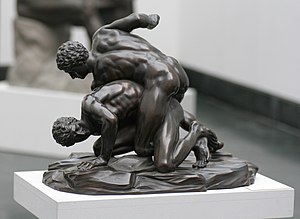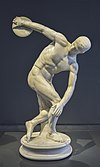Arrichione di Figaleia (scritto anche Arrhachion, Arrichion o Arrachion) (in greco Αρριχίων ο Φιγαλεύς?) (Figaleia, ... – 564 a.C.) è stato un campione di pancrazio greco antico nei Giochi olimpici antichi.
Morì mentre difendeva con successo il suo campionato nel pancrazio alla 54ª Olimpiade (564 a.C.).[1][2] Arrichione è stato descritto come "il più famoso di tutti i pancrazisti".[3]
Storia
[modifica | modifica wikitesto]
Arrichione vinse nel pancrazio, uno sport da combattimento che mescola pugilato e lotta, alla 52ª e 53ª Olimpiade (572 a.C. e 568 a.C., rispettivamente).[4] Il suo incontro fatale è stato descritto dal geografo Pausania e da Filostrato il Giovane.[3] Secondo Pausania:
«For when he was contending for the wild olive with the last remaining competitor, whoever he was, the latter got a grip first, and held Arrhachion, hugging him with his legs, and at the same time he squeezed his neck with his hands. Arrhachion dislocated his opponent's toe, but expired owing to suffocation; but he who suffocated Arrhachion was forced to give in at the same time because of the pain in his toe. The Eleans crowned and proclaimed victor the corpse of Arrhachion.»
«Quando stava contendendo l'olivo selvatico all'ultimo concorrente rimasto, chiunque fosse, quest'ultimo lo bloccò per primo e tenne Arrachione, bloccandolo con le gambe, e allo stesso tempo gli strinse il collo con le mani. Arrachione slogò l'alluce del suo avversario, ma morì a causa del soffocamento; ma colui che lo soffocò fu costretto allo stesso tempo a cedere a causa del dolore al dito del piede. Gli Elidi incoronarono e proclamarono vincitore il cadavere di Arrachione.»
Il racconto di Filostrato è più lungo. Nei suoi Imagines, una visita immaginaria in una galleria d'arte, Filostrato descrive un dipinto della morte di Arrichione.[5] Nella traduzione di Arthur Fairbanks:
«Accordingly the antagonist of Arrichion, having already clinched him around the middle, thought to kill him; already he had wound his forearm about the other’s throat to shut off the breathing, while, pressing his legs on the groins and winding his feet one inside each knee of his adversary, he forestalled Arrichion’s resistance by choking him till the sleep of death thus induced began to creep over his senses. But in relaxing the tension of his legs he failed to forestall the scheme of Arrichion; for the latter kicked back with the sole of his right foot (as the result of which his right side was imperiled since now his knee was hanging unsupported), then with his groin he holds his adversary tight till he can no longer resist, and, throwing his weight down toward the left while he locks the latter’s foot tightly inside his own knee, by this violent outward thrust he wrenches the ankle from its socket.»
«Perciò l'antagonista di Arrichione, dopo averlo già bloccato alla vita, pensò di ucciderlo; aveva già avvolto l'avambraccio intorno alla gola dell'altro per interromperne il respiro, mentre, premendo le gambe sull'inguine e avvolgendo i piedi uno dentro ogni ginocchio dell'avversario, prevenne la resistenza di Arrichione soffocandolo fino a che il sonno mortale così indotto non cominciò ad annebbiargli i sensi. Ma allentando la tensione delle gambe non riuscì a prevenire il piano di Arrichione; quest'ultimo scalciò all'indietro con la pianta del piede destro (a quel punto il suo fianco destro era stato messo in pericolo poiché ora il suo ginocchio pendeva senza supporto), quindi con l'inguine tenne stretto il suo avversario fino a quando non poté più resistere, e, gettando il suo peso verso il basso a sinistra mentre bloccava saldamente il piede di quest'ultimo dentro il proprio ginocchio, con questa violenta spinta verso l'esterno gli strappò la caviglia dall'orbita.»
Filostrato di Atene scrive nel suo Ginnasticus che il fallimento di Arrichione nel sottomettersi al suo avversario fu colpa del suo allenatore, Eressia, che gli gridò: "Che nobile epitaffio, 'Non fu mai sconfitto ad Olimpia '".[3][7][8]
Una statua Arrichione venne eretta a Figaleia; quella che si crede sia la stessa statua è ora esposta nel museo di Olimpia.[3][9][10] È una delle più antiche statue di vincitore olimpico datate.[11]
Nella cultura
[modifica | modifica wikitesto]Arrichione è stato oggetto di una poesia, Arrichion, di Jeanette Threlfall, in cui la poetessa lamenta il fatto che l'atleta sia vissuto e morto prima che San Paolo portasse il cristianesimo in Grecia.[12][13]
Note
[modifica | modifica wikitesto]- ^ (EN) Robert H. Brophy, Deaths in the Pan-Hellenic Games: Arrachion and Creugas, in The American Journal of Philology, vol. 99, n. 3, Johns Hopkins University Press, 1978, pp. 363–390.
- ^ a b (EN) Pausania, Description of Greece, su perseus.tufts.edu. URL consultato il 10 settembre 2020.
- ^ a b c d H. A. Harris, Greek Athletes and Athletics, Londra, Hutchinson & Co, 1964, p. 108.
- ^ (EN) David Matz, Greek and Roman Sport: A Dictionary of Athletes and Events from the Eighth Century B.C. to the Third Century A.D., McFarland & Company, 1991, p. 32, ISBN 978-0899505589.
- ^ (EN) William Blake Tyrrell, The Smell of Sweat: Greek Athletics, Olympics, and Culture, Wauconda, Illinois, Bolchazy-Carducci Publishers, Inc, 2004, pp. 138–140, ISBN 0-86516-553-X.
- ^ (EN) Filostrato il Vecchio e Filostrato il Giovane, Imagines, collana Loeb Classical Library, traduzione di Arthur Fairbanks, Cambridge, Londra, Harvard University Press; William Heinemann Ltd, 1969, p. 153.
- ^ (EN) Nigel James Nicholson, Aristocracy and Athletics in Archaic and Classical Greece, Cambridge, Cambridge University Press, 2005, p. 129, ISBN 978-0-521-84522-9.
- ^ (EN) Ancientolympics, su ancientolympics.arts.kuleuven.be, 2012. URL consultato il 10 settembre 2020.
- ^ (EN) Walter Woodburn Hyde, Olympic victor monuments and Greek athletic art, Washington, Carnegie Institution of Washington, 1921, pp. 326–328. URL consultato il 10 settembre 2020.
- ^ (EN) Barry R. Harker, Strange Fire: Christianity and the Rise of Modern Olympism, Rapidan, Virginia, Hartland Publications, 1996, p. 2, ISBN 0-923309-49-7.
- ^ (EN) Walter Woodburn Hyde, The Oldest Dated Victor Statue, in American Journal of Archaeology, vol. 18, Archeological Institute of America, 1914, pp. 156–164.
- ^ (EN) J. T., Arrichion, in The Christian Lady's Magazine, vol. 30, n. 3, Seeleys, settembre 1848, pp. 240–243.
- ^ (EN) Jennette Threlfall, Sunshine and Shadow. Poems, London, William Hunt and Company, 1873, pp. 24–27.
Collegamenti esterni
[modifica | modifica wikitesto]- (EN) Ancientolympics, su ancientolympics.arts.kuleuven.be, 2012.
- (NL) Postume olympisch kampioen, su sportgeschiedenis.nl.
- (EN) George M. Hollenback, Arrichion's Last Fight: What Really Happened?, in Journal of Combative Sport, Electronic Journals of Martial Arts and Sciences, settembre 2003, ISSN 1492-1650. URL consultato il 18 settembre 2012.









